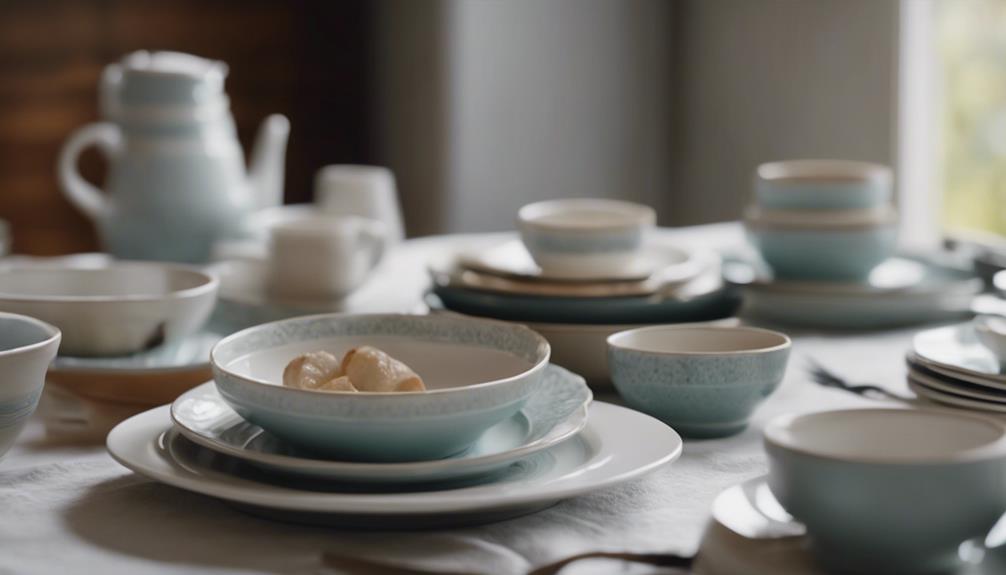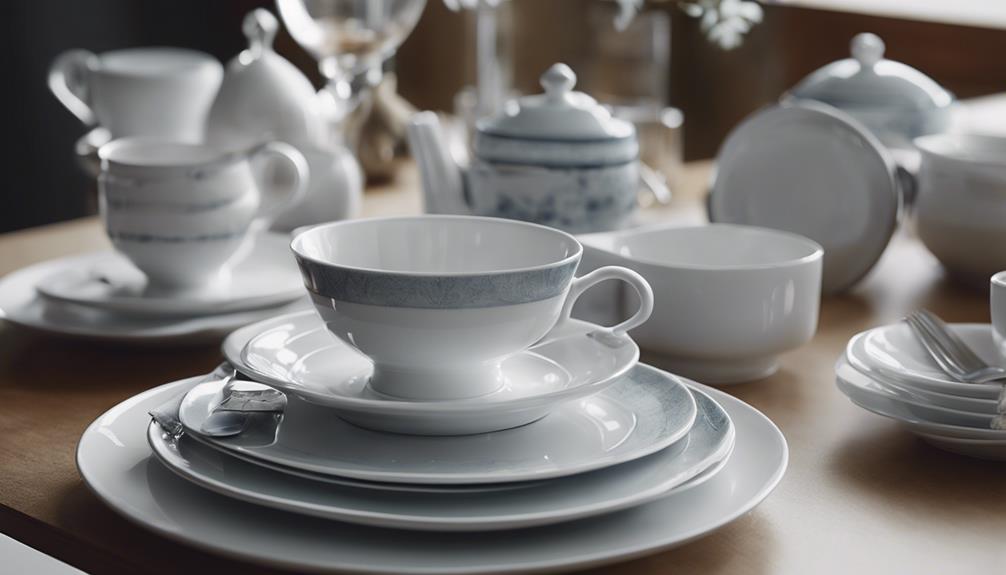Tableware includes materials such as earthenware, stoneware, bone china, porcelain, and ceramic, each with its own unique qualities like rustic charm, durability, elegance, and sturdiness. Its origins can be traced back to early pottery and medieval times, when precious metals were commonly used. Trenchers were once popular as plates. Tableware, influenced by different cultures, symbolizes harmony and unity. Proper etiquette, especially when using chopsticks, is crucial. Western and Asian styles vary in both design and tradition. Customizable and sustainable options are now available to meet modern requirements. Delve deeper into the world of tableware to gain a better understanding beyond its surface.
Key Takeaways
- Tableware encompasses various utensils and items used in dining.
- It includes plates, bowls, cups, cutlery, and serving dishes.
- Materials range from earthenware to porcelain and bone china.
- Tableware reflects cultural influences and historical traditions.
- Designs can be traditional, modern, or customized to suit preferences.
Tableware Materials

When considering tableware materials, ceramic options like earthenware, stoneware, bone china, and porcelain stand out for their durability and aesthetic appeal. Earthenware is known for its rustic charm and affordability, making it a popular choice for everyday use. Stoneware, with its sturdiness and earthy colors, is great for both casual and formal settings. Bone china, a delicate yet strong material, exudes elegance and is often used for special occasions. Porcelain, prized for its delicate appearance and chip-resistant nature, is a top choice for fine dining experiences.
These examples showcase the versatility and beauty of ceramic materials in tableware. Whether you prefer the simplicity of earthenware, the resilience of stoneware, the sophistication of bone china, or the elegance of porcelain, there's a ceramic option to suit every taste and occasion. Ceramic tableware not only adds style to your dining table but also offers durability that can withstand the rigors of everyday use or elevate special moments.
Tableware History
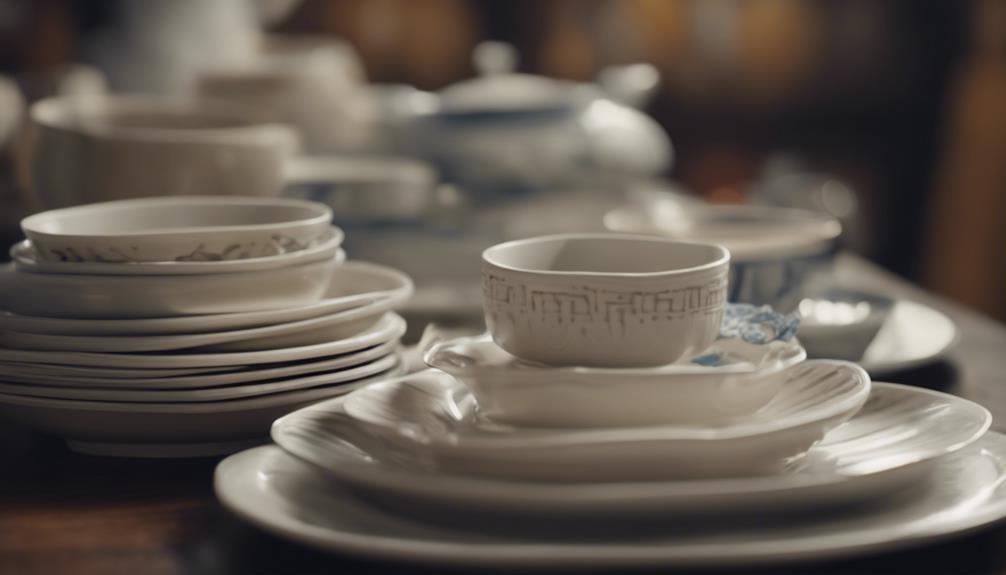
Tableware history traces back to early pottery, with a focus on pots and jars before flatware gained prominence.
Precious metals like gold and silver were favored by ancient elites for their flatware.
Medieval cuisine featured trenchers, bread rounds used as plates, reflecting the evolution and cultural influences on tableware.
Tableware Origins
During ancient times, tableware primarily consisted of functional pottery items like pots and jars rather than flatware. Plates, as we understand them today, weren't common. Instead, people used trenchers, which were bread rounds serving as plates in medieval cuisine.
The elites of ancient civilizations displayed their wealth through tableware made of precious metals like gold and silver. Ownership of elaborate tableware was regulated by sumptuary laws to signify social status.
Surprisingly, the scarcity of surviving examples of medieval tableware is attributed to plate melting for financial gain. This practice led to the destruction of many historical pieces, limiting our understanding of tableware origins during that era.
Evolution of Tableware
Rarely are historical artifacts as telling of societal norms and cultural values as the evolution of tableware throughout history. Early pottery primarily focused on pots and jars rather than flatware like dinner plates.
Ancient elites displayed their status by using precious metals such as gold and silver for their tableware. In medieval times, trenchers, which were bread rounds used as plates, were commonly employed.
Tableware ownership wasn't just about functionality but also served as a symbol of wealth, often regulated by sumptuary laws. Unfortunately, plate melting for financial gain during the Middle Ages has resulted in limited surviving examples from that era.
The evolution of tableware reflects not only changes in dining habits but also shifts in social hierarchies and economic circumstances.
Cultural Influences on Tableware
The cultural influences on tableware can be traced through the materials and designs chosen by different societies across history. When considering table setting, these influences become evident:
- Early pottery focused on pots and jars rather than flatware, showcasing the practicality of everyday dining essentials.
- Ancient elites favored precious metals like gold and silver for tableware, highlighting luxury and status during meals.
- Trenchers, bread rounds used as plates, were common in medieval cuisine, reflecting resourcefulness and simplicity in table settings.
- Tableware ownership was regulated by sumptuary laws as a symbol of wealth, shaping social hierarchies and etiquette at the dining table.
Plates and Vessels
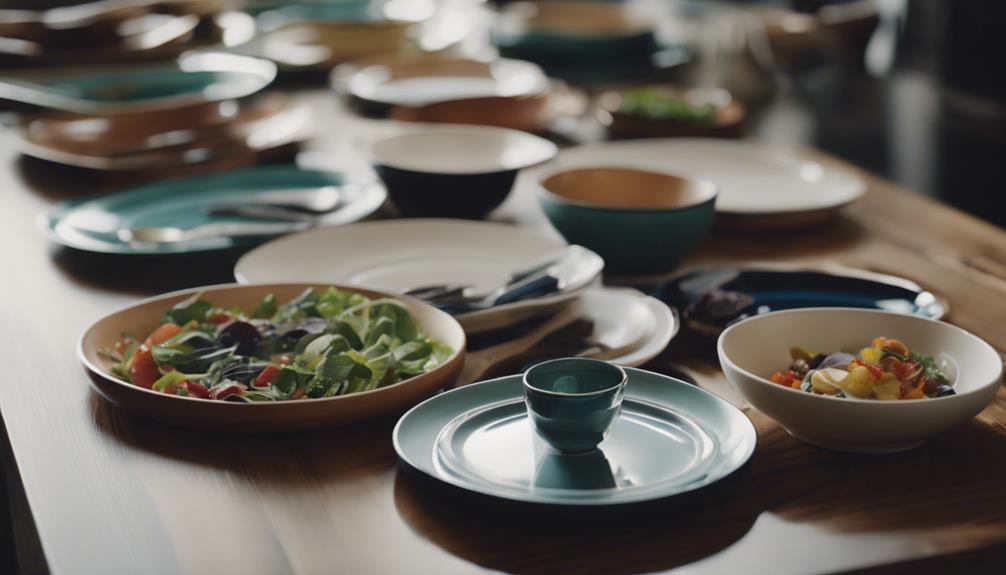
When it comes to tableware, understanding the types of materials used in plates can enhance your dining experience. The materials of plates, such as ceramic, glass, porcelain, or melamine, offer a variety of options to suit different occasions.
Vessels also play a significant role in dining experiences. They come in different shapes like bowls for serving soups, salads, or side dishes, adding to the overall presentation at the table.
Plate Materials
Plate materials for tableware, ranging from traditional ceramics to modern alternatives like wood and metal, offer a diverse selection for dining and serving needs. When choosing plate materials, consider the following options:
- Ceramic Materials: Including earthenware, stoneware, bone china, and porcelain, ceramics are popular for their durability and elegant designs.
- Wood: Provides a natural and rustic look to your table setting, adding warmth to your dining experience.
- Metals: Such as pewter, offer a sophisticated and timeless appeal, ideal for special occasions.
- Tempered Glass, Acrylic, and Melamine: These materials provide lightweight and practical options, suitable for outdoor dining or casual settings.
With these varied plate material choices, you can select based on your style preferences and practical needs.
Vessel Shapes
Exploring the diverse shapes of vessels in tableware, including plates and other essential components, reveals the artistry and functionality behind each piece. Plates play a vital role in dining experiences, coming in various shapes like round, square, oval, and rectangular. These different plate shapes cater to various dining styles and preferences, enhancing the presentation of meals.
Round plates are versatile and traditional, while square plates offer a modern aesthetic. Oval and rectangular plates provide a unique twist to table settings, adding visual interest. The shape of a plate can influence the overall dining experience, from how food is arranged to the style of cuisine being served.
Choose the plate shape that best complements your dining ambiance and culinary creations.
Cutlery Overview

In the world of dining etiquette and culinary culture, understanding cutlery is essential for maneuvering formal and casual dining experiences. Here are some key points to help you grasp the basics of cutlery:
- Types of Cutlery: Cutlery includes knives, forks, and spoons, serving both functional and decorative purposes.
- Terminology: In various regions, cutlery may be referred to as silverware or flatware, highlighting cultural differences in naming conventions.
- Materials: Stainless steel is a popular choice for cutlery due to its durability and resistance to corrosion, ensuring longevity and ease of maintenance.
- Placement: In formal dining settings, the arrangement of cutlery on the table varies depending on the number of courses, showcasing attention to detail and etiquette awareness.
Understanding these aspects of cutlery won't only enhance your dining experience but also showcase your appreciation for the nuances of tableware.
Chopsticks Usage

When using chopsticks, mastering the proper grip technique is essential for efficient handling.
Understanding the cultural significance attached to chopsticks can deepen your appreciation for their use.
Etiquette and traditions surrounding chopsticks usage play a vital role in dining customs across various East Asian countries.
Proper Grip Technique
To master the art of using chopsticks effectively, it's essential to understand and practice the proper grip technique. Here are some key points to help you improve your chopstick grip:
- Pinch Grip: Hold one chopstick stationary at the base of your thumb and index finger while moving the other chopstick with your thumb and remaining fingers.
- Balanced Grip: Hold both chopsticks like a pencil for increased control and precision when picking up food.
- Enhanced Dining Experience: Mastering the correct chopstick grip technique can make eating with chopsticks more efficient and enjoyable.
- Practice and Patience: Developing a comfortable and effective chopstick grip technique takes time and dedication, but it's worth it for savoring various cuisines.
Cultural Significance
Mastering the proper grip technique for chopsticks not only enhances your dining experience but also holds significant cultural significance in various Asian countries. Chopsticks are traditional utensils used in China, Japan, Korea, and Vietnam, with designs reflecting cultural preferences.
In Chinese culture, chopsticks symbolize unity and harmony, commonly used in family gatherings and special events. Etiquette surrounding chopsticks is important; avoid pointing them at others, sticking them upright in food, or passing food between pairs directly.
Modern chopsticks come in various materials like metal, plastic, bamboo, and even luxury options such as gold or silver for special occasions. Understanding the cultural importance of chopsticks adds depth to your dining experience and shows respect for Asian traditions.
Etiquette and Traditions
Understanding proper chopstick etiquette is crucial for respecting Asian dining traditions and avoiding cultural faux pas. When using chopsticks, remember these key points:
- Hold them correctly: Grip chopsticks towards the end to guarantee control and precision.
- Avoid certain gestures: Never point chopsticks at others or stick them upright in food.
- Pass food mindfully: Don't transfer food directly from one pair of chopsticks to another.
- Use them in pairs: In Chinese culture, chopsticks are typically used in pairs to honor tradition and show respect.
Table Decoration Styles
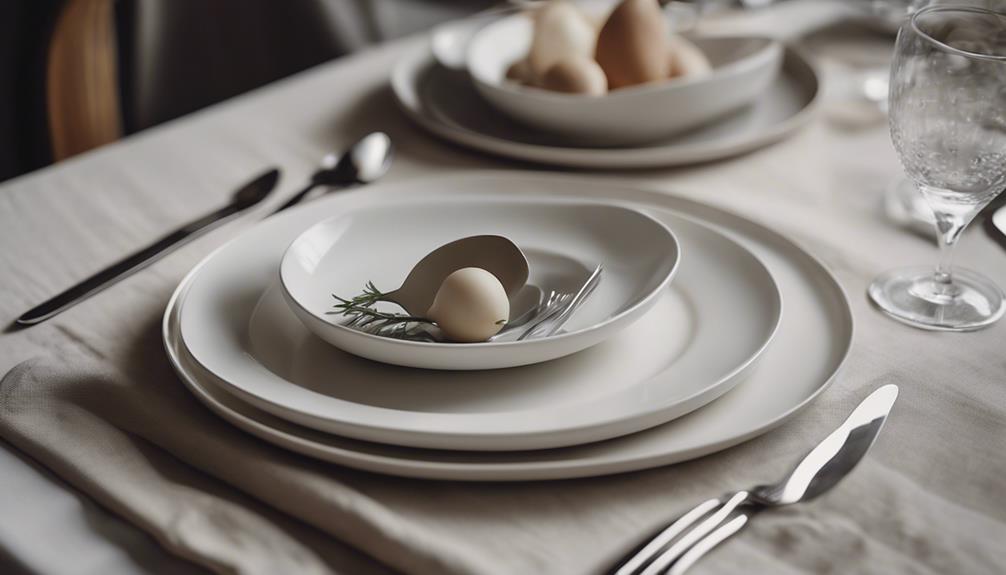
Table decoration styles encompass a diverse range of aesthetics, from traditional to modern and minimalist designs.
In the past, ephemeral items like sugar or ice sculptures were commonly used for decoration. However, in the 18th century, porcelain figurines gained popularity and replaced these sculptures as decorative elements on tables.
Traditionally, precious metals such as silver were also favored for ornate table decorations. Nonetheless, as time progressed, porcelain emerged as a more popular choice for table decoration during the same period, displacing precious metals.
These changes reflect the evolving tastes and trends in table decoration styles over the centuries. Whether you prefer the opulence of silver or the delicate beauty of porcelain, there are various options to suit different preferences and settings when it comes to adorning your table.
Western Table Settings

When arranging Western table settings, attention to detail is essential for creating an elegant dining experience. Here are some key elements to ponder for your place settings:
- Service Styles: Traditional Western table settings follow two main styles: service à la russe and service à la française.
- Cutlery Placement: In service à la russe, cutlery is positioned based on the number of courses being served, ensuring a seamless dining experience.
- Glassware Arrangement: Different glasses like water, red wine, and white wine glasses are set according to the course requirements, complementing the meal perfectly.
- Serving Dishes: Serving dishes such as butter dishes and casseroles play a vital role in enhancing the overall dining experience, adding a touch of elegance to the table.
Asian Tableware Styles

Asian tableware styles guarantee intricate designs, vibrant colors, and symbolic motifs such as dragons, cherry blossoms, or bamboo, reflecting rich cultural heritage and artistic traditions.
In Asian dining culture, soup bowls hold a significant place, serving as vessels for comforting and nourishing soups like miso or ramen. Japanese tableware, known for its minimalist elegance, often includes beautifully crafted soup bowls designed to enhance the dining experience. These bowls aren't only functional but also aesthetically pleasing, with delicate patterns and soothing colors.
Chinese soup bowls, on the other hand, may feature intricate floral designs or classic blue and white porcelain, adding a touch of elegance to the dining table. Korean soup bowls, like stone bowls used for bibimbap, are known for their durability and ability to retain heat, keeping your food warm throughout the meal.
The diversity of Asian tableware styles ensures a delightful dining experience filled with cultural richness and artistic beauty.
Tableware Adaptations

With an evolving dining landscape, contemporary adaptations in tableware have revolutionized the way we experience meals, incorporating innovative designs and sustainable materials. These adaptations cater to changing preferences and trends in dining aesthetics, focusing on sustainability and functionality. Here are some key adaptations:
- Modern Designs: Tableware now includes sleek and stylish options to enhance your dining experience and reflect current trends.
- Sustainable Materials: Bamboo, recycled glass, and biodegradable alternatives are popular choices, contributing to eco-friendly dining practices.
- Space-Saving Designs: Stackable tableware makes storage easier, ideal for smaller living spaces without compromising on style.
- Customizable Options: Personalize your table settings with monograms, colors, and patterns to create unique and individual place settings for special occasions.
These adaptations not only offer practical solutions but also add a touch of personalization to your dining setup, making each meal more memorable and enjoyable.
Tableware Insights

As we explore Tableware Insights, consider the significance of selecting matching tableware to enhance your dining experience. Plates, glasses, and flatware are vital components of tableware. When these items match, such as having plates and bowls that complement each other, they contribute to a cohesive and visually appealing dining setup.
Using clean tableware is essential not only for presentation but also for serving food and drinks in a hygienic manner. Dishwashers can be valuable tools for efficiently cleaning tableware while maintaining its quality.
Proper storage of tableware is also significant as it can help prolong the lifespan of your plates, glasses, and flatware, ensuring they remain in good condition for a longer period. By paying attention to these insights and taking care of your tableware, you can elevate your dining experience and create a welcoming atmosphere for yourself and your guests.
Frequently Asked Questions
What Is the Meaning of Tableware?
Tableware comprises items like plates, glasses, and cutlery used during meals. These objects are important for serving food and drinks in a dining setting. Having matching tableware, like plates and bowls, enhances the dining experience.
It's vital to maintain cleanliness to uphold hygiene standards and guarantee food safety. Dishwashers can efficiently clean and sanitize tableware, making them indispensable tools in the kitchen.
What Is the Purpose of Tableware?
When setting the table, remember that tableware isn't just for show; it's there to serve a vital purpose. From holding your food to enhancing your dining experience, tableware plays an essential role.
What Is Tableware and Its Types?
Tableware encompasses items like plates, glasses, and flatware for meals. It includes dinner plates, salad plates, glassware, and flatware. Materials range from ceramic to stainless steel.
Chargers and serving platters are used for formal dining. Clean tableware is important for serving food, with dishwashers being effective for cleaning. Specialized pieces enhance dining experiences for various occasions.
It's vital to have a range of tableware to suit different needs and settings.
What Is Tableware and Flatware?
Tableware includes dishes, glassware, and utensils for serving and eating. Flatware, a subset of tableware, consists of knives, forks, and spoons. Both are essential for dining.
Materials like stainless steel, silver, and wood are common for flatware. Quality and design greatly influence the dining experience.
Choose tableware and flatware wisely to enhance both function and aesthetics of your meals.
Conclusion
So, now you know all about tableware and its fascinating history.
From the elegant Western table settings to the intricate Asian tableware styles, there's a whole world of dining etiquette to explore.
Whether you're using traditional plates and vessels or opting for modern adaptations, tableware plays a vital role in any meal.
So next time you set the table, remember the rich heritage and timeless charm of these essential dining tools.
Happy dining!



